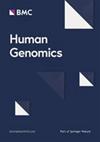循环血脂与巴雷特食管和食管癌的因果关系:双向、双样本泯灭随机分析
IF 3.8
3区 医学
Q2 GENETICS & HEREDITY
引用次数: 0
摘要
循环血脂与巴雷特食管(BE)和食管癌(EC)的因果关系一直是一个争论不休的话题。本研究旨在阐明循环血脂与巴雷特食管癌和食管癌风险之间的因果关系。我们使用从公开的 IEU OpenGWAS 数据库中获得的循环血脂(n = 94,595 - 431,167 人)、BE(218,792 人)和 EC(190,190 人)的单核苷酸多态性(SNPs)进行了双样本孟德尔随机化(MR)分析。采用反方差加权法(IVW)、加权中值法、MR-Egger 法和 MR-PRESSO 法确保了结果的稳健性和可靠性。通过MR-Egger截距检验、Cochran's Q检验和leave-one-out敏感性分析,评估了工具变量的水平多向性、异质性和稳定性。此外,还进行了双向磁共振和多变量磁共振(MVMR),以分别探索反向因果关系和调整已知混杂因素。所有测试方法均未发现具有统计学意义的水平多效性、方向多效性或异质性。使用 IVW 进行的单变量 MR 分析表明,甘油三酯增加与 BE 之间存在稳健的因果关系(几率比 [OR] = 1.79,P 值 = 0.009),而与 EC 之间则无明显关联。反向 MR 分析表明,没有证据表明上述结果存在反向因果关系。在 MVMR 分析中,甘油三酯(TRG)升高与 BE 风险显著正相关(OR = 1.79,p 值 = 0.041)。这项磁共振研究表明,遗传性甘油三酯升高与 BE 风险升高密切相关,将来有可能成为诊断 BE 的生物标志物。本文章由计算机程序翻译,如有差异,请以英文原文为准。
The causal associations of circulating lipids with Barrett’s Esophagus and Esophageal Cancer: a bi-directional, two sample mendelian randomization analysis
The causal associations of circulating lipids with Barrett’s Esophagus (BE) and Esophageal Cancer (EC) has been a topic of debate. This study sought to elucidate the causality between circulating lipids and the risk of BE and EC. We conducted two-sample Mendelian randomization (MR) analyses using single nucleotide polymorphisms (SNPs) of circulating lipids (n = 94,595 − 431,167 individuals), BE (218,792 individuals), and EC (190,190 individuals) obtained from the publicly available IEU OpenGWAS database. The robustness and reliability of the results were ensured by employing inverse-variance weighted (IVW), weighted median, MR-Egger, and MR-PRESSO methods. The presence of horizontal pleiotropy, heterogeneities, and stability of instrumental variables were assessed through MR-Egger intercept test, Cochran’s Q test, and leave-one-out sensitivity analysis. Additionally, bidirectional MR and multivariable MR (MVMR) were performed to explore reverse causality and adjust for known confounders, respectively. None of the testing methods revealed statistically significant horizontal pleiotropy, directional pleiotropy, or heterogeneity. Univariate MR analyses using IVW indicated a robust causal relationship between increased triglycerides and BE (odds ratio [OR] = 1.79, p-value = 0.009), while no significant association with EC was observed. Inverse MR analysis indicated no evidence of reverse causality in the aforementioned outcomes. In MVMR analyses, elevated triglycerides (TRG) were significantly and positively associated with BE risk (OR = 1.79, p-value = 0.041). This MR study suggested that genetically increased triglycerides were closely related to an elevated risk of BE, potentially serving as a biomarker for the diagnosis of BE in the future.
求助全文
通过发布文献求助,成功后即可免费获取论文全文。
去求助
来源期刊

Human Genomics
GENETICS & HEREDITY-
CiteScore
6.00
自引率
2.20%
发文量
55
审稿时长
11 weeks
期刊介绍:
Human Genomics is a peer-reviewed, open access, online journal that focuses on the application of genomic analysis in all aspects of human health and disease, as well as genomic analysis of drug efficacy and safety, and comparative genomics.
Topics covered by the journal include, but are not limited to: pharmacogenomics, genome-wide association studies, genome-wide sequencing, exome sequencing, next-generation deep-sequencing, functional genomics, epigenomics, translational genomics, expression profiling, proteomics, bioinformatics, animal models, statistical genetics, genetic epidemiology, human population genetics and comparative genomics.
 求助内容:
求助内容: 应助结果提醒方式:
应助结果提醒方式:


